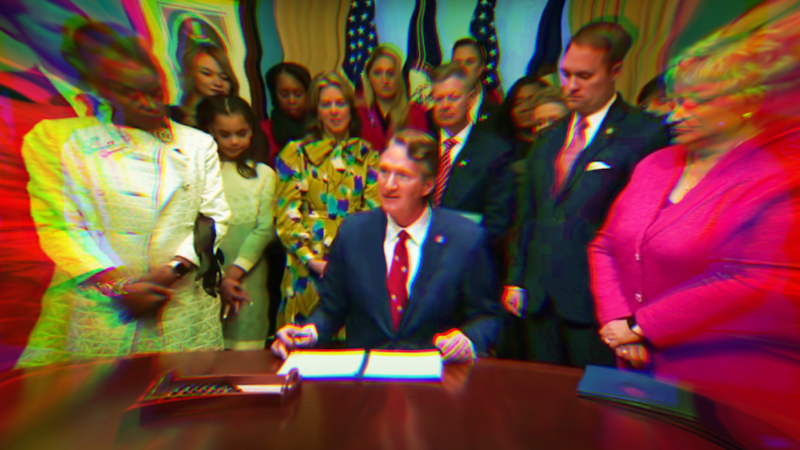I’ve just finished up a rough draft of this article (6 years in the making), and I thought I’d serialize it here, minus most of the footnotes (which you can see in the full PDF). I’d love to hear people’s reactions and recommendations, since there’s still plenty of time to edit it. You will also be able to see all the posts, as they come up, here.
[* * *]
Craig is trying to force Danielle to do something, by explicitly or implicitly threatening to criminally retaliate if she doesn’t go along. And, as often happens, Craig’s threatened crime is endangering not just Danielle but also innocent bystanders.
Should the legal system require Danielle to comply with the demands, on pain of civil liability (for negligent injury or nuisance), or even of criminal punishment (for disturbing the peace or perhaps reckless endangerment)? Or should Danielle have, in effect, a right to defy Craig’s demands, even if this means a higher risk to bystanders?
These questions can arise in many different situations:
- Danielle’s abortion clinic has been firebombed in the past, by people who want it to close or at least to leave town. Neighbors sue the clinic, claiming its operation is a nuisance, because it makes them fearful that future attacks will harm them as well.[1] If the neighbors win, that in effect means that Danielle had a legal duty to comply with the arsonists’ demands (at least to the extent of moving to a place that may be more expensive for her, and less convenient for patients).
- The clinic is indeed attacked again, and neighbors or visitors who are injured sue the clinic for negligently increasing the risk of such attack. The same can of course apply to any controversial business or enterprise, such as a church, synagogue, or mosque; an animal experimentation facility; a political organization; or a bookstore that sells books that contain the Mohammed cartoons or other material that highly offends some people.[2]
- A store is being robbed. Danielle, a store employee, refuses to go along with the robbers’ demands that she turn over money, so they injure a customer to accentuate those demands. The customer sues the store, claiming the employee’s actions foreseeably increased the risk of the injury. If the customer wins, that in effect means that Danielle had a legal duty to comply with the robber’s demands.
- Craig kidnaps Danielle’s employee, and demands ransom. Danielle refuses to pay, so Craig kills the employee; the employee’s family sues Danielle for negligence, claiming that she had a duty to pay the ransom.
- Danielle and her fellow protesters carry signs insulting a religion. Craig and a group of his friends start throwing things at the protesters. The police order the protesters to leave, hoping to keep the confrontation from escalating,[3] and threaten to punish them with prosecution for breach of the peace or for resisting a lawful order if they don’t comply.
A version of this problem also arises when Craig hasn’t expressly demanded that Danielle do something, but rather Craig obviously doesn’t want Danielle to do it:
- Danielle dances suggestively with a new lover in front of her estranged husband Craig (whom Danielle knows to be jealous). Craig shoots the lover, whose relatives sue Danielle for wrongful death, claiming her actions created a risk of injury by enraging Craig.[4] Again, their prevailing would mean that Danielle in effect had a duty to comply with Craig’s implicit demands not to show romantic affection for others in front of him.
- Danielle lets her niece stay at her home, because the niece is fleeing Craig, the niece’s violent estranged husband. Craig comes to Danielle’s house to attack the niece and Danielle, and the gardener gets caught in the crossfire. The gardener’s relatives sue Danielle for wrongful death, claiming her actions created a risk of injury by foreseeably enraging Craig.[5]
And a version of this problem arises with the “duty to retreat” that thirteen states still recognize in self-defense cases, and the more general “duty to comply with a negative demand” that seven states still recognize. These “duties” don’t threaten criminal punishment or civil liability just for defying a criminal’s demands (whether the demands are just “leave,” as in the duty to retreat, or “stop doing X” in the duty to comply). But the “duties” do provide that a victim who refuses to go along with certain demands is stripped of her legal right to use lethal force in self-defense should such force be required.
- Danielle dances suggestively at a bar with a new lover in front of her estranged husband Craig. Craig demands that they stop, but they don’t. Craig tries to knife Danielle, but she shoots him in self-defense. Danielle is then prosecuted, because state law provides that deadly force can’t be used in self-defense if “[t]he actor knows that he can avoid the necessity of using such force with complete safety … by complying with a demand that he abstain from any action which he has no duty to take.”
- A racist mob demands that Danielle leave the place where she lawfully is. She refuses, and she is attacked with deadly force; she defends herself with deadly force, and is then prosecuted because she failed to retreat.[6]
All these cases, I think, involve a tension between two approaches to the risk of retaliatory violence. We might call one approach the immediate pragmatism approach:
- The unfortunate reality is that a criminal is threatening to retaliate against some lawful action X.
- That reality creates serious risks to bystanders.[7]
- This pragmatic concern has a moral component: The bystanders have the right not to be unreasonably endangered.
- Even innocent victims of the threat thus have a duty to try to minimize such risks, even if that requires some constraint on their liberty.
And we might call the opposite approach the right to defy criminals’ demands approach:
- Everyone has the right to act without having to obey criminals’ demands (or criminals’ expected wishes, which would in effect be implied demands).
- The law shouldn’t step in on the side of the criminal by adding the threat of criminal liability, civil liability, or liability for self-defense to the criminals’ threats.
- This moral concern has a pragmatic component: By giving legal force to the criminal’s unlawful demands, the law would encourage more such unlawful demands.
- Even innocent bystanders should thus have no claim on the innocent victims that would require the victims to obey the criminals.
In some of these situations, this right to defy has been recognized (though not under that name). In others, the right has been rejected. In others, the matter is unsettled.
In this Article, I will try to chart the scope of this right, and the authority for and against it. To my knowledge, this is the first attempt to do so in a way that draws connection between these various areas; and I hope that showing these connections can more clearly illuminate the core principles underlying the right.
And I will argue that, on balance, such a right is sound: Generally speaking, the legal system should let people insist on their liberty, in the face of violent threats, and in the face of the danger that is therefore created by such defiance. Contrary to a claim often made against the duty to retreat, the question isn’t so much letting people preserve honor or reputation or “manliness,” but letting them preserve liberty—freedom from domination by criminals—and the dignity that comes with such liberty.[8] Some may argue that this liberty and dignity comes at too high a cost, and ought to be restrained to protect bystanders, or even to protect the criminals. But whatever the right bottom line, we should acknowledge the cost of such a safety-first approach.[9]
To be sure, when our activities cause hazards to others, we often have to cease those activities, at least if the magnitude of the hazard is seen as “unreasonable.” We are expected to avoid off-loading those hazards onto our neighbors or our visitors. Thus, for instance, if our commercial establishment attracts vermin that then go onto neighbors’ land, and there’s nothing we can do stop it, we might have to close up shop or move to an area where there are no neighbors nearby.
But if our establishment attracts criminal enemies who try to force us to stop operating, and in the process the criminals create a threat to our neighbors (whether as a deliberate tactic or just as a side effect of their attacks), we shouldn’t have to close or move. To the extent our behavior is a but-for cause of the criminal hazard to our neighbors, that is a hazard that our neighbors should have to bear, as part of the common danger all of us face from criminals. It is the law’s job to prevent crime, chiefly by deterring and incapacitating criminals. If the law instead arms our neighbors or the police with the right to stop our behavior when criminals so demand (through threat of civil liability or criminal punishment), the law is arming criminals with an extra weapon against us.
The legal system needn’t worry about incentive effects on animals (“if garbage dumps have to move because they attract rats, this will give an incentive to rats”), but it should worry about incentive effects on humans (if abortion clinics have to close or move because arsonists threaten to burden them down, this will provide an incentive for such threats). And having to do things to prevent harmful animal incursions doesn’t undermine our dignitary interests the same way that having to comply with human criminals’ demands does.
In what follows, I hope to lay this out in more detail. I begin by discussing how a possible right to defy criminals arises as to negligence (Part I), nuisance (Part II), criminal law generally (Part III), and the duties to retreat and comply (Part IV). In Part V, I discuss possible limits on the right to defy: for instance, perhaps Danielle’s behavior may still be punishable if it’s independently wrongful (e.g., fighting words); if it has the specific purpose of provoking violence; if forbidding that behavior imposes only a modest intrusion on liberty (one possible rationale for a limited duty to retreat); if the behavior is legal but constitutionally unprotected; or if her defiance is unreasonable. Or perhaps even if Danielle’s behavior may not be legally punishable, it should still lead to a lesser penalty for the criminal who is provoked by such behavior.
Finally, Part VI will ask whether it’s legitimate for the law to require expensive precautions against threats, short of requiring compliance with criminal demands—for instance, by requiring threatened people or institutions to hire armed guards, put up physical barriers, or warn visitors or neighbors of the threat.[10] I think these precautions aren’t as violative of the threat victims’ dignity, because they don’t enlist the state on the side of the criminal threatener. At the same time, courts and legislatures should be cautious about imposing such obligations, because they do let the threateners use the legal system to impose potentially massive costs on their victims. And, I’ll argue, that is especially so when the duty is a duty to warn, which may intrude on the victims’ privacy and lead people to shun them.
[1] These are roughly the facts of McBrayer v. Governors Ridge Off. Park Ass’n, Inc., 860 S.E.2d 58 (Ga. Ct. App. 2021), which led to a $1.5 million verdict in favor of the neighbors; the court of appeals reversed the verdict. I filed an amicus brief in this case on behalf of various law professors (including myself) and advocacy groups, urging reversal.
[2] Cf. Charlie Hebdo Shooting: Belgian Bookstores Selling Magazine Sent Warning Letters; Muslim Leaders Condemn New Magazine Issue, ABC News (Australia) (Jan. 14, 2015, 1:08 PM) (“‘I recommend that you do not spread these cartoons of our beloved Mohammed in this despicable Charlie Hebdo magazine, at the risk of reprisals against you and your horrible business,’ the letters said ….”).
[3] See Bible Believers v. Wayne County, 805 F.3d 228, 239 (6th Cir. 2015) (en banc).
[4] This is based on Hurn v. Greenway, 293 P.3d 480 (Alaska 2013); see also Touchette v. Ganal, 922 P.2d 347 (Haw. 1996); Starr v. Gregory, No. 53-2004CA-000161, 2004 WL 5213002 (Fla. Cir. Ct. Polk Cnty. Oct. 19, 2004); John C.P. Goldberg & Benjamin C. Zipursky, Intervening Wrongdoing in Tort: The Restatement (Third)’s Unfortunate Embrace of Negligent Enabling, 44 Wake Forest L. Rev. 1211, 1217 (2009) (“A woman is aware of her ex-boyfriend’s violent jealousy, as well as his occasional appearances at a bar located in their small town. She nonetheless agrees to meet a date for a drink at the bar. If her ex-boyfriend shows up and proceeds to pummel her date, she is subject to liability [under the Restatement (Third) of Torts.”).
[5] Cf. Rojas v. Diaz, No. B144346, 2002 WL 1292996 (Cal. Ct. App. June 12, 2002).
[6] This is based on the facts of Laney v. United States, 294 F. 412 (D.C. Cir. 1923). The issue can arise even with solo racist attackers, see, e.g., Commonwealth v. Benoit, 892 N.E.2d 314, 327 (Mass. 2008) (concluding that self-defense was indeed unavailable in such a case).
[7] Even violent self-defense against the threatener, as in the last two examples, can create a risk to bystanders who might get caught in the shootout when the threatener responds, or in any future cycle of retaliation.
[8] In principle this would also apply to tortious demands: Say the abortion opponents in example 1 don’t firebomb the clinic but instead just libel the clinic’s neighbors, and the neighbors sue the clinic claiming that the clinic’s continuing presence is a foreseeable cause of the libel; I’m inclined to say that there too the clinic shouldn’t be held liable. But I’m not sure whether there would be libel liability in such a case. (Some libel cases allow lawsuits against an original libeler based on republication by third parties when such republication is “reasonably to be expected,” Restatement (Second) of Torts § 576(c) (1977), but I’ve seen none that allow lawsuits against a nonlibeler whose actions foreseeably lead to libels.) And more broadly, it would be a rare scenario where a demand would be merely tortious and not criminal, and would at the same time threaten an innocent bystander in a manner for which the target of the demand would normally be legally liable.
[9] I don’t claim that this dignitary interest is a general constitutional right as such (except in specific situations, such as speakers’ or abortion clinics’ refusal to obey shutdown demands). But I think it is a facet of liberty that the legal system ought to protect.
[10] See, e.g., Rocky Mountain Planned Parenthood, Inc. v. Wagner, 467 P.3d 287 (Colo. 2020).
The post The Right to Defy Criminal Demands: Introduction appeared first on Reason.com.
from Latest – Reason.com https://ift.tt/3nw6pEP
via IFTTT


